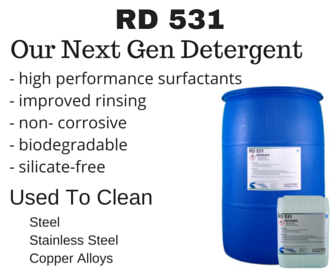
Improving Adhesion in PVD & TiN Coatings with Ultrasonics & Water-Based Detergents
“Unlocking the coating process: Exploring the chemistry behind ultrasonic cleaning prior to PVD (Physical Vapor Deposition) coatings and better adhesion on titanium nitride coated carbide cutting tools.”
In this post, we explore the issues that face pretreatment cleaning prior to PVD coating, shedding light on the carefully formulated chemical solutions that accompany this crucial pre-coating process. From dissolving stubborn oils from the machining process, to neutralizing surface oxides, and preventing cobalt leeching in tungsten carbide cutting tools, each component plays a vital role in priming substrates for the impeccable finish required for PVD and more specifically titanium nitride coatings.
Surface Preparation
- Ultrasonic cleaning is a crucial step in surface preparation before coating. It removes contaminants such as oil, grease, dust, fingerprints, and other particulates from the substrate surface. These contaminants, if not removed, can interfere with the adhesion of the coating, leading to poor quality and adhesion failure.
Enhanced Adhesion
- Proper cleaning through ultrasonic agitation ensures that the substrate surface is free from any residues that could inhibit adhesion. This allows the PVD coating to adhere more effectively to the substrate, resulting in a stronger bond between the coating and the material underneath.
Uniform Coating Thickness
- Contaminants on the substrate surface can cause uneven coating thickness during the coating process. Ultrasonic cleaning helps achieve a uniform surface, ensuring consistent coating thickness across the entire substrate.
Minimizes Defects
- Surface contaminants can lead to defects such as pinholes, bubbles, and delamination. Ultrasonic cleaning effectively removes these contaminants, minimizing the likelihood of defects and ensuring a smooth, defect-free coating surface. This is particularly important for high-performance applications where even minor defects can compromise the functionality or aesthetics of the coated product.
Improves Surface Finish
- In addition to removing contaminants, ultrasonic cleaning can also improve the surface finish of the substrate by removing surface oxides and other imperfections. A cleaner, smoother surface promotes better adhesion and enhances the overall appearance of the coated part.
Increases Process Efficiency
- It reduces the need for rework or rejection of parts due to coating defects, leading to greater process efficiency and cost savings. Additionally, cleaner substrates require less frequent maintenance of coating equipment, reducing downtime and improving productivity.
Supports Wide Range of Substrates
- Ultrasonic cleaning is suitable for a variety of substrates commonly used in PVD coating applications, including metals, ceramics, glass, and plastics. It offers versatility and adaptability to different material types and shapes, making it an essential pre-treatment step in PVD coating processes across various industries such as automotive, aerospace, medical devices, and consumer electronics.
Environmental and Safety Benefits
- Ultrasonic cleaning detergents typically utilizes water-based cleaning solutions, which are environmentally friendly and pose minimal health and safety risks compared to solvent-based cleaning methods. This makes ultrasonic cleaning a more sustainable and safer option for substrate preparation compared to the typical solvent based products used.
Cobalt Leeching in Carbide: Understanding the Phenomenon
In the realm of materials science and engineering, carbide materials, often composed of tungsten carbide (WC) grains embedded in a cobalt (Co) matrix, reign supreme for their exceptional hardness, wear resistance, and versatility across various industries. However, beneath their seemingly impenetrable surface lies a subtle yet significant process known as cobalt leeching.
Cobalt leeching occurs when cobalt atoms within the carbide matrix migrate towards the surface of the material and eventually into surrounding environments. This phenomenon is particularly prevalent when cleaning with an incompatible chemical or in harsh conditions where the carbide substrate is subjected to high temperatures, mechanical stress, or corrosive environments.
Factors to Consider
- Thermal and Mechanical Stress: High temperatures and mechanical forces can promote the diffusion of cobalt atoms within the carbide matrix, weakening the bonds between cobalt and tungsten carbide grains and facilitating their migration towards the surface
- Chemical Reactions: Exposure to corrosive chemicals or environments can trigger chemical reactions that accelerate cobalt leeching. These reactions may result in the formation of cobalt compounds that are more soluble or reactive, further facilitating cobalt migration.
- Microstructural Changes: Changes in the microstructure of the carbide material, such as grain boundary diffusion or phase transformations, can create pathways for cobalt atoms to migrate towards the surface, increasing the propensity for leeching.
- Surface Degradation: Surface defects, cracks, or porosity in the carbide material can provide pathways for cobalt atoms to escape from the matrix and leech into surrounding environments, leading to surface degradation and loss of material integrity.
Consequences of Cobalt Leeching
- Reduced Wear Resistance: Cobalt leeching can deplete the cobalt matrix within the carbide material, compromising its hardness, wear resistance, and overall performance in abrasive or erosive environments.
- Coating Contamination: Cobalt leeching can contaminate adjacent materials or coatings during processing or use, affecting their properties and performance
- Environmental Impact: Leached cobalt compounds may pose environmental and health risks, particularly in applications where carbide materials are used in contact with food, water, or biological systems.
Preventing Cobalt Leeching
To mitigate cobalt leeching and preserve the performance and longevity of carbide materials, careful selection of materials, surface treatments, and operating conditions is essential.
Understanding the mechanisms and implications of cobalt leeching in carbide materials is essential for optimizing their performance, durability, and sustainability across a wide range of industrial applications. By addressing the root causes of cobalt leeching and implementing the appropriate pretreatment steps, engineers and manufacturers can unlock the full potential of the coating process.
RD 531
- A silicate-free heavy-duty detergent for use in soak and ultrasonic cleaning systems
- Excellent for removal of machining oils, polishing, and lapping compounds
- Specially effective in cleaning carbide cutting tools without cobalt leaching
- Used on steel, stainless steel, and copper alloys

Want to know more about detergents for ultrasonic cleaners? Contact the specialists at our equipment division, Miraclean Cleaning Systems, or our chemical division, Chautauqua Chemicals Co., Inc. or find out more at 716-763-4114 or email us at info@cchemco.com.
